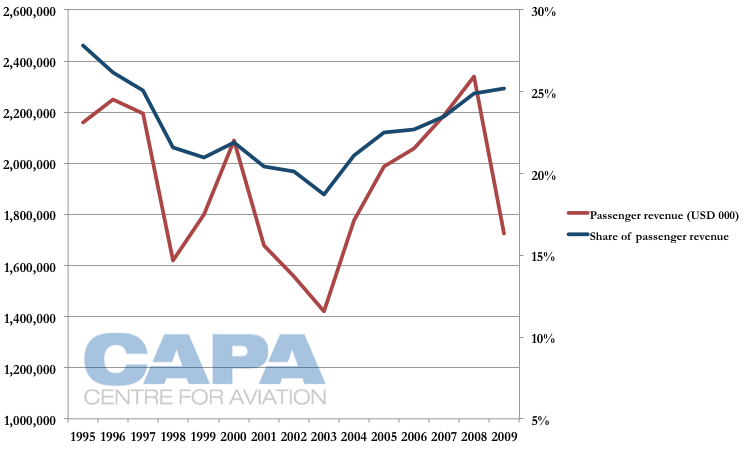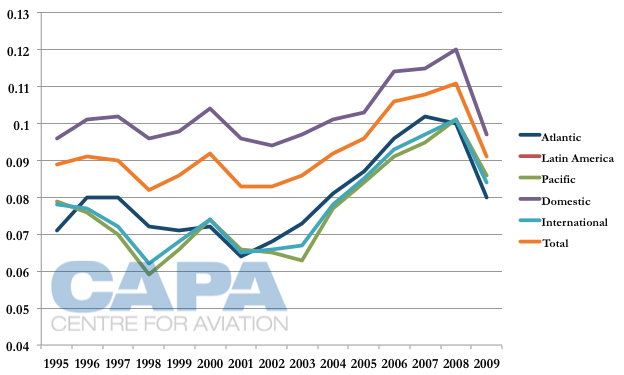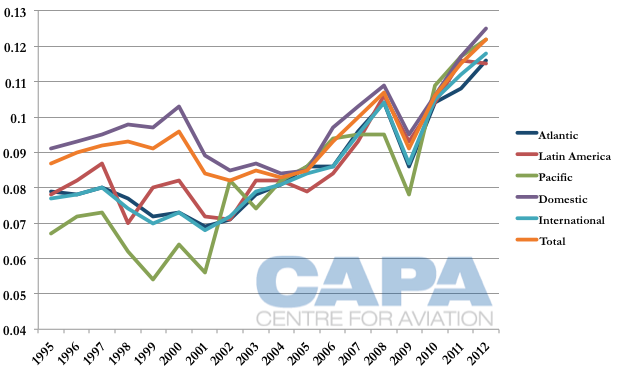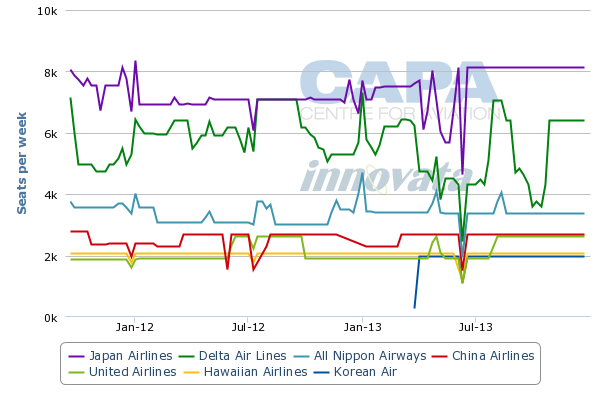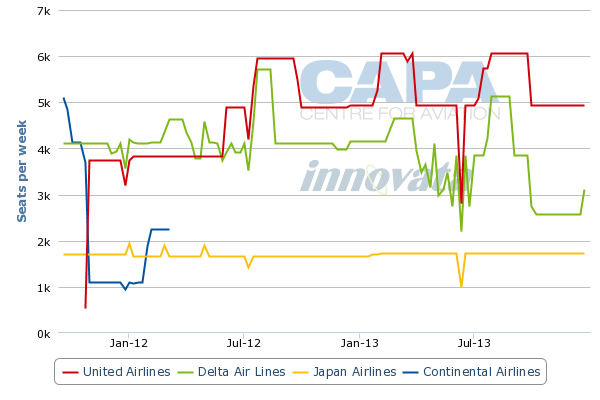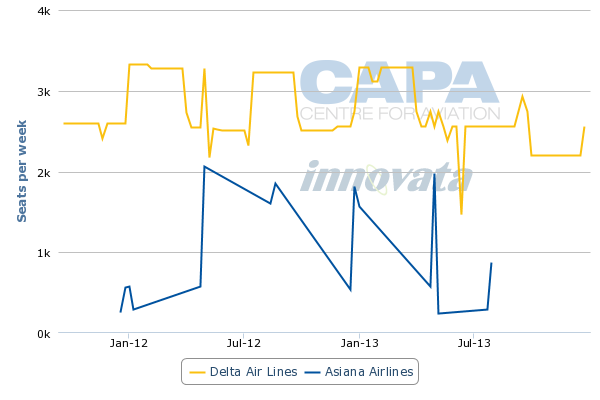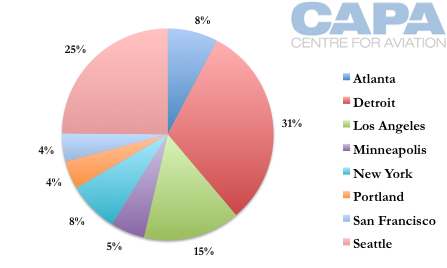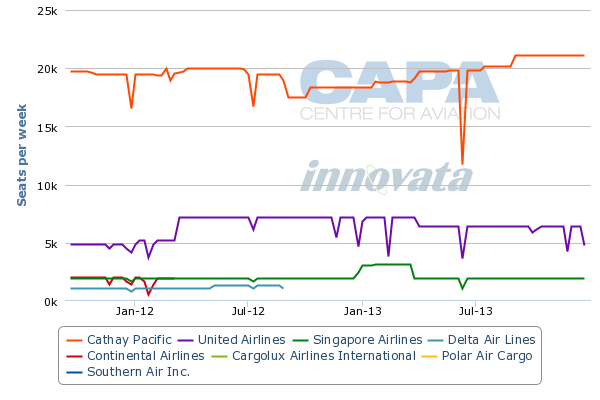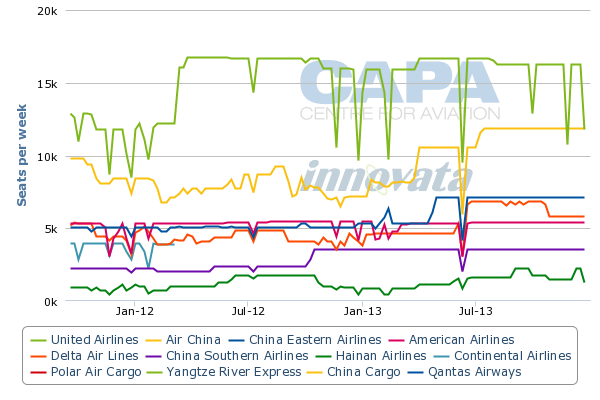Delta Air to use its Chinese SkyTeam partners to grow, connecting over the main hubs
The Asia Pacific region was once the laggard for Delta Air Lines. Despite the region's size, it seldom accounted for more than 3% of Delta's revenue or capacity. Asia Pacific yields were some of Delta's lowest. That changed after Delta's merger with Northwest. The region, notably Japan, was an important market for Northwest, accounting for as much as a quarter of its revenue and capacity. While Delta inherited size in Asia-Pacific, it did not receive quality: Northwest's yields were not outstanding. That has started to change and North Pacific yields in recent years are some of Delta's highest.
That is giving Delta a platform to grow. The carrier recently introduced additional services to Shanghai and Tokyo, and in the future is specifically looking to introduce a non-stop service to Taipei and re-introduce a non-stop flight to Hong Kong. The result should be to help it diversify beyond Japan, which still sees the majority of Delta's trans-Pacific capacity - despite being the only one of the big three US carriers not to have an immunised partnership with a Japanese airline.
Delta's China growth in the medium term will not follow United Airlines in serving secondary Chinese cities from the US, instead preferring connecting options with its strong SkyTeam partners China Eastern and China Southern. Delta may not rival United as the largest US carrier in Asia, but it is still far ahead of American Airlines.
Asia Pacific was barely on Delta's radar prior to the Northwest merger
Asia Pacific was a minor preoccupation for pre-merger Delta. Passenger revenue from the region was typically 2% of passenger revenue, according to data Delta supplies to US DOT and interpreted by the MIT Airline Data Project. That figure is about the same when looking at total revenue, which includes cargo. While one might expect Asia-Pacific to have a higher share when including cargo given the region's concentration of freight, Delta's historical Asia-Pacific capacity relied on MD-11s, which did not live up to payload expectations. That also partially explains Delta's limited footprint in the region as it simply did not have the equipment.
But there was also considerable inertia that kept the airline focused on the domestic US market, which as recently as 2003 accounted for 80% of total passenger revenue. That percentage began to fall and in 2009, just prior to completing the Northwest merger, domestic accounted for 57% of total passenger revenue. That fell to 55% right after the Northwest merger.
Delta Pacific passenger revenue share of total passenger revenue: 1995-2012
Northwest merger gave Delta quantity but not quality
In contrast, Northwest was very internationally minded. With KLM in the 1990s it set up the industry's first anti-trust immunised alliance. While Delta in the late 1990s/early 2000s had domestic passengers comprise 80% of passenger revenue, Northwest was around 65%. Asia-Pacific was a significant contributor, accounting for 20-25% of passenger revenue.
Northwest Pacific passenger revenue share of total passenger revenue: 1995-2009
Delta inherited Northwest's network, a downright blessing. But quantity was not matched with quality. Northwest's Asia-Pacific yields (RASM and reported as "Pacific") were often the lowest and dragged down its average. Long-haul routes are typically lower-yielding than short-haul, reflecting the lower cost of long-haul travel compared to short-haul, but Asia-Pacific lagged trans-Atlantic services considerably, and Northwest was known for cheap - but lacklustre - travel.
Northwest RASM by region and average: 1995-2009
Product improvements have seen Asia-Pacific's performance greatly improve for Delta
Delta has set about improving its post-merger image, retrofitting its long-haul aircraft to have fully flat seats in business class and personal TV screens in economy, even on ageing 747-400s and 767-300s. These changes and others are paying off, with Delta's Pacific yields since the merger typically the highest or second highest of its regions, pushing Delta's average up.
In fact, Delta's 2012 Pacific yield (USD12.2 cents) was higher than the yield from any of Northwest's regions since at least 1995 (the peak was USD12 cents in the domestic market in 2007).
Delta RASM by region and average: 1995-2012
Delta's Pacific revenue grew 27% from 2010 to 2012. In the same period capacity grew only 13% while RPMs grew 10%, underscoring the genuine yield improvements beyond higher yields because of fuel surcharges and the Yen's appreciation.
Delta is still concentrated in Japan; larger than American but smaller than United
Delta is the second largest carrier between Asia-Pacific and the United States. It is about 80% the size of United, but about 60% bigger than the next largest competitor, Korean Air. Delta is also nearly three times the size of the only other mainland US carrier serving Asia-Pacific, American Airlines.
Top 10 Airlines ranked on seat capacity between Asia-Pacific and the United States: 8-Jul-2013 to 14-Jul-2013
| Rank | Airline | Total Seats | |
|---|---|---|---|
| 1 | UA | United Airlines | 118,266 |
| 2 | DL | Delta Air Lines | 92,456 |
| 3 | KE | Korean Air | 58,698 |
| 4 | JL | Japan Airlines | 54,588 |
| 5 | NH | All Nippon Airways | 40,476 |
| 6 | CX | Cathay Pacific | 39,626 |
| 7 | AA | American Airlines | 32,256 |
| 8 | HA | Hawaiian Airlines | 30,366 |
| 9 | QF | Qantas Airways | 29,212 |
| 10 | CI | China Airlines | 24,928 |
As CAPA previously wrote, Delta differs from United in Asia-Pacific in that its capacity is highly concentrated in Japan whereas United and even American have diversified, which allows them to tap into markets without a Tokyo stopover. Delta's position is also precarious owing to swings that could emanate from the Japanese market if factors change - as they did in 2011 after the Japanese earthquake and the current depreciation of the Yen.
Delta, unlike American and United, does not have a local partner in Japan, reducing connecting options, although Delta operates a large intra-Asia hub at Narita inherited from Northwest. Delta could in theory partner with Skymark in the long-term, if the domestic Japanese carrier makes IT changes, although pending regional Asian expansion (not actively discussed at Skymark), this would only give Delta access to other parts of Japan and not other markets around Asia.
Curiously there is no deep, JV-level relationship between Delta and Korean Air. Korean Air mooted a closer relationship in 2012, suggesting and end to any hard feelings about Delta so aggressively targetting JAL to be its partner in 2011, after JAL's bankruptcy There are logistical challenges: Delta is concentrated in Japan, not Korea, but having more friends is always better in today's unpredictable but growing market.
See related reports:
- US-Japan airline alliances become lopsided as JAL, ANA expand while US to shift to other markets
- Skymark Airlines risks being caught in the middle of Japan's legacy heavyweights and new LCCs
American, Delta and United US-Asia/Pacific available seat distribution share by country: 2003 & 2013
| Airline | 2003 | 2013 |
|---|---|---|
| American Airlines |  |
 |
| Delta Air Lines | 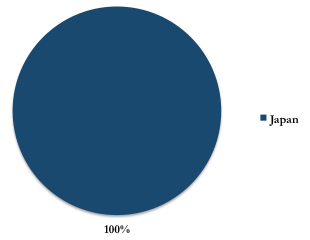 |
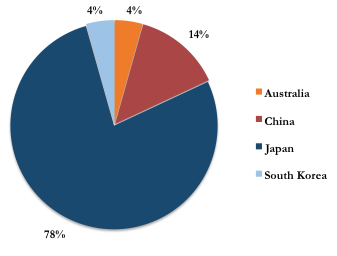 |
| United Airlines | 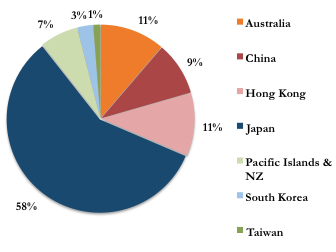 |
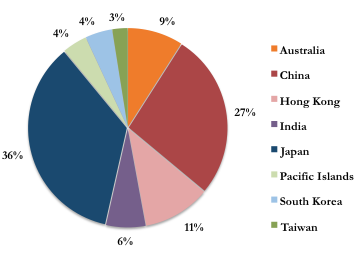 |
Just as times get good, the yen gets bad; capacity cuts to "beach markets" from Japan
Just as Delta was beginning to level off with having lie-flat beds on all long-haul flights and other service changes, the Japanese yen began to depreciate, upwards of 25%. This is in line with the country's efforts to weaken the yen to make Japanese exports more affordable. While airlines have been trying to downplay this impact on the historically large Japanese outbound market, there are a few signs of change, albeit small.
Delta is trimming capacity to its so-called "beach markets", destinations served from Japan to US islands like Hawaii, Guam and Saipan. These routes are almost entirely catering to the outbound Japanese market, which being leisure in nature is very sensitive to price swings resulting from the yen's fall, which makes foreign holidays more expensive.
Delta's Oct-2013 capacity between Honolulu and Tokyo (Delta's largest US-Asia route based on seat capacity) will be down 28%. But another development in this market is Korean Air's recent entry, which has come with very low introductory fares. JAL and United will be slightly up in capacity in Oct-2013. But so far in early Dec-2013 Delta will have a 27% increase for the peak Christmas season year-over-year.
Honolulu International Airport to Tokyo (seats per week, one way): 19-Sep-2011 to 29-Dec-2013
Guam-Tokyo will see about a 38% decrease in capacity. Competitors JAL and United on the route are so far holding steady.
Guam Antonio B Won Pat International to Tokyo Narita (seats per week, one way): 19-Sep-2011 to 29-Dec-2013
The smaller Tokyo-Saipan market will see a 15% decrease later in 2013.
Saipan International Airport to Tokyo Narita Airport (seats per week, one way): 19-Sep-2011 to 29-Dec-2013
Non-stop flight to Hong Kong is to be re-introduced
Delta in Jun-2012 announced from Aug-2012 it would end its daily 777-200LR Detroit-Hong Kong service, launched in 2010. Delta's daily Tokyo Narita-Hong Kong 777 service remains. Delta found Detroit did not offer as much local traffic to Hong Kong as it anticipated, making it reliant on more volatile connecting traffic. Its equipment use of higher fuel burning 777-200LRs would not have been as efficient as the 777-300ERs Cathay Pacific operates to North America, or some of United's 777-200ER services to Hong Kong.
See related report: Delta's 4Q2012 international route cuts free up significant widebody capacity
Delta is undeterred, with VP Asia-Pacific Vinay Dube seeing the route's axing less of a reflection of the Hong Kong market's potential than Delta selecting the wrong US originating city. Delta intends to resume a non-stop service but from a different US city. Of Delta's larger US cities for service to Asia, the largest, Detroit, is out. The second largest, Seattle, is interesting.
There is no service to Hong Kong, unlike Delta's other big cities for Asian flights, Los Angeles and New York, which see large capacity from both Cathay Pacific and United. Cathay does have two daily flights to Vancouver, just over the US-Canada border. One of those flights continues to New York JFK. But Vancouver has a large expatriate Cantonese population, which combined with the not insignificant road distance and traffic congestion between Vancouver and Seattle, largely makes the two markets separate from each other. A number of foreign airlines, including British Airways and EVA Air, have long-haul routes to both Seattle and Vancouver.
Distribution by seat capacity of US mainland cities for Delta trans-Pacific services: 8-Jul-2013 to 14-Jul-2013
New York may not necessarily be ruled out as Cathay could use competition at New York JFK - although it has three daily direct flights and the one daily via Vancouver - while United serves Hong Kong from Newark, pulling in a slightly different pool of traffic.
Routes from Hong Kong to the United States ranked on seat capacity: 8-Jul-2013 to 14-Jul-2013
| Rank | Origin | Destination | Total Seats | ||
|---|---|---|---|---|---|
| 1 | HKG | Hong Kong International Airport | SFO | San Francisco International Airport | 9,527 |
| 2 | HKG | Hong Kong International Airport | LAX | Los Angeles International Airport | 6,600 |
| 3 | HKG | Hong Kong International Airport | JFK | New York John F Kennedy International Airport | 5,940 |
| 4 | HKG | Hong Kong International Airport | ORD | Chicago O'Hare International Airport | 4,214 |
| 5 | HKG | Hong Kong International Airport | EWR | New York Newark Liberty International Airport | 1,904 |
Hong Kong to United States (seats per week, one way): 19-Sep-2011 to 29-Dec-2013
Delta is likely to start non-stop Taipei-US service, following United's lead
Delta intends in due course to introduce a non-stop service from the US to Taipei in Taiwan. Delta is currently the only scheduled mainland US carrier in Taiwan, serving Taipei from its Asian hub at Tokyo Narita with a daily 747-400 service. This level of capacity has seen Delta aggressively target the US-Taiwan market, often considerably undercutting fares from China Airlines and EVA Air. Hawaiian Airlines in Jul-2013 commenced services to Taipei from Honolulu.
United in Jul-2012 announced its intention to resume services to the Taiwanese market via a daily 747-400 from San Francisco to Taipei. United exited the low yield route during the 2008 fuel price increases. Taiwan's economy is growing and United now has a local partner in the form of EVA Air, which in Jun-2013 joined United's Star Alliance.
In recent months United and EVA have been introducing beyond-Taipei codeshares, giving more substance to United's foray than before. The plan was delayed, however, with the early-2013 grounding of the 787 Dreamliner, which required United to re-deploy its long-haul fleet to cover for the 787. One of those aircraft redeployed was the one needed for United's Taipei service. Although the 787 is back in service, United elected to postpone the route launch until 2014 to coincide with the start of the high season, ensuring the route commenced on a positive note.
See related reports:
- United excludes Houston in new domestic and international push from US hubs
- EVA Air, now in Star Alliance, looks to grow regionally and long-haul, increasing transfer traffic
EVA Air is the largest carrier between Taiwan and the US, with about 40% more capacity than China Airlines. EVA Air's long-haul routes are mainly filled with sixth-freedom passengers, although its network is profitable, unlike at China Airlines, whose ageing 747-400s and A340s challenge profitability.
Taiwan to United States (seats per week, one way): 19-Sep-2011 to 29-Dec-2013
Where might Delta serve Taipei from? Its largest continental US hub for Asian flights, Detroit, sees no services to Taipei from EVA Air or China Airlines. Detroit has volume for connections but as with the Detroit-Hong Kong flight, may not have enough local traffic.
Delta's second largest US hub for Asian flights, Seattle, sees five weekly flights from EVA, which intends eventually to bring this to a daily offering. Delta's next largest hub, Los Angeles, sees the most Taipei capacity, although Delta has the advantage of its North American corporate contracts. Route distance is less of a factor as Taipei's southern geography means there is no opportunity to serve the city from Seattle with a 767-300 or A330, as Delta does from Seattle to some more northern Asian cities.
Routes from Taiwan to the United States ranked on seat capacity: 8-Jul-2013 to 14-Jul-2013
Delta's China strategy is partners, not diversification
Delta is a far smaller player in the US-China market. It was only in mid-2013 (with the launch of Seattle-Shanghai services) that it had more US-China capacity than American Airlines, which is otherwise smaller in Asia than Delta. Delta's presence in China though is boosted when considering services from its Tokyo Narita hub, which includes daily flights to Beijing and Shanghai. In Jul-2013 Beijing is served with a 767-300 while Shanghai receives a 747-400. Equipment fluctuates during the year based on aircraft rotation across Delta's Pacific network.
Taking these flights into account, Delta's weekly Jul-2013 capacity into China surpasses American's, with about 22,000 seats to American's 11,000. United has about 33,000. While American may have more US-China capacity than Delta, Delta serves Tokyo Narita from eight US cities (American from four). This enables a large volume of one-stop traffic from the US to China via Tokyo.
American relies on domestic US connections to China, which are limited given its fewer flights to China and fewer trans-Pacific hubs. Delta's Tokyo services, which are generally timed to connect with intra-Asia services, are from a number of cities around the US, reducing circuitous connections.
China to United States (seats per week, one way): 19-Sep-2011 to 29-Dec-2013
While Delta in Jun-2013 opened the service from Seattle to China's financial heart of Shanghai, and the hub of SkyTeam partner China Eastern, competitor United is looking to grow in China by launching service from the US to secondary Chinese cities with the 787. Although details are few, United CEO Jeff Smisek in mid-2012 flagged cities like Chengdu, Chongqing, Xi'an and Wuhan as candidates.
United's move would usher in the start of North American carriers serving Chinese cities other than Beijing or Shanghai. China Southern has North American routes from Guangzhou, China's manufacturing heart that has lower-yielding point-to-point traffic than Beijing or Shanghai. A route from United would also expand direct links to North America from secondary Chinese cities. The only North American service from a city other than Beijing, Guangzhou or Shanghai is Sichuan Airlines' Chengdu-Shenyang-Vancouver service. European carriers have been serving secondary Chinese cities for a few years now.
Three reasons why Delta will not fly directs - low yields, no suitable aircraft; but willing partners exist
Delta is not planning to serve secondary Chinese cities in the medium-term, Dube says. He explains Delta does not think traffic premiums will be high enough.
Also a likely factor is equipment. United's explicit flagging of using the 787 is significant. The 787 is ideally suited to long and thin routes; United's 787 seats 219. United's next smallest aircraft that would be capable of serving an inland secondary city (and not a northeastern city like Shenyang or Dalian) is the 777-200, which seats at least 258 at United, and has a higher operating cost.
Northwest was to be the North American launch customer for the 787, but Delta postponed those orders. Without A350s on order, Delta is left without aircraft that can serve long and thin routes.
In absence of this new type of growth, Delta is looking to grow its presence via Beijing and Shanghai and connections on its SkyTeam partners China Eastern and China Southern, which are the two largest domestic carriers in China (Air China is third).
The partnership story is also a factor. United's partner Air China is the largest carrier between China and the US. But Air China, always the privileged son in Beijing, is much more reluctant than its peers to share its wealth with partners. United and Air China codeshare on trans-Pacific services as well as beyond gateway flights, critical for Air China's Beijing-Houston service launched in Jul-2013. But there is much greater competition between the two than exists between Delta and China Eastern and China Southern. China Southern's sole US service is a daily A380 flight from Guangzhou to Los Angeles. China Eastern serves Los Angeles and New York daily and only in 2013 added San Francisco.
Whereas Air China and United dominate the China-US market, Delta, China Eastern and China Southern are the underdogs; but they have strength in numbers - a strategy at the core of China Eastern and China Southern, which co-operate to some degree in the domestic market and share their SkyTeam allegiance to mutual benefit.
In Shanghai, Delta can use the extensive network of China Eastern, based there, while at Beijing China Southern has a large enough network that Delta estimates can accommodate 80% of connections. China Southern serves 38 Chinese cities from Beijing.
Top 10 domestic airports China Southern serves from Beijing Capital ranked on seat capacity: 8-Jul-2013 to 14-Jul-2013
| Rank | Airport | Total Seats | |
|---|---|---|---|
| 1 | CAN | Guangzhou Baiyun Airport | 23,437 |
| 2 | URC | Urumqi Airport | 13,123 |
| 3 | SZX | Shenzhen Airport | 11,471 |
| 4 | DLC | Dalian Airport | 9,614 |
| 5 | CGQ | Changchun Airport | 7,456 |
| 6 | SHE | Shenyang Airport | 7,021 |
| 7 | CSX | Changsha Airport | 6,943 |
| 8 | HRB | Harbin Airport | 6,448 |
| 9 | KWE | Guiyang Airport | 5,705 |
| 10 | SYX | Sanya Airport | 5,012 |
Given the improvements Delta has made in Asia Pacific and merger partner Northwest's historical presence in the region, it is disappointing not to see Delta grow in new growth markets like secondary Chinese cities.
But with the growth to come out of China, both from natural demand and from increasingly relaxed visa formalities that allow easier access, there are many more chapters to be written about Delta's presence in China.
See related reports:
- United Airlines aims to open secondary Chinese cities with the 787
- Delta Air Lines improves China position with better slots from partners China Eastern & Southern
- Delta leverages its strength in Seattle and Alaska Airlines partnership to bolster service to Asia
Aircraft orders to funnel more growth
Delta has 727 aircraft in service, according to CAPA's Fleet Database. A quarter of those aircraft are widebodies.
Delta Air Lines Fleet Summary: as at 12-Jul-2013
Among its relatively small order book, Delta primarily has narrowbody aircraft on order, aside from 18 787s not due to commence delivery until 2020. Delta is beginning to realise its widebody shortage and long-haul opportunities, and the carrier is expected to shortly place an order for a small - likely under 20 - number of widebodies for delivery in the short-term.
In 2014/2015 a second and larger order is expected to cover deliveries for after 2017, when Delta's 747-400s will be approaching 30 years of service.
Delta has a platform for growth - but the scene is shifting and Delta, appears not to be
Today's US carriers are vastly different in outlook from a decade ago, but they are still relatively lacking in their international mindset, focusing on the domestic market and then typically Europe. This is particularly true for Delta, with its domestic-focussed history.
There is volume domestically and across the Atlantic and with a very large, 700-plus aircraft fleet, it is easier to manage when allocating much of it in a centralised way - especially when the vast majority of the airline's managers is comfortable and familiar with those markets. Delta is able to extract a rent from its singular dominance domestically and, having been through a lengthy process of developing North Atlantic alliance relationships, eventually succeeding in gaining an anti-trust immunised partnership with them, it is natural to want to extract maximum value from it.
That is a sensibly comfortable - albeit hardly innovative - strategy for the present, but it can hardly be a road map for the future. Those roads are mostly attractive in the rear view mirror. Today they are low growth, at a time when opportunities are fast developing in other areas.
No doubt there are growth opportunities today in many areas that Delta - and others - are missing. As Asia continues to grow and complex visa and other border restrictions are relaxed - China is experiencing strong growth, Taiwan is on visa waiver and Hong Kong may be soon - that demand can be realised.
Establishing a presence in new environments is not an overnight event. And, even more importantly, where management and board room discussions focus on domestic and European markets, it takes time to refocus the strategic attention and understanding necessary to enable sound decision making. Only 16% of Delta's capacity is currently allocated to international operations and, of that, only 18% shows in north Asia - even with the platform established by Northwest Airlines historical routes.
Foreign carriers have limitations serving these markets, like high cost bases in Japan; meanwhile Chinese carriers are still navigating through international marketing and experience. There may be time to delay, but unless there is a recognised timeline to move on these opportunities, they and their potential profits are evaporating. And the gap in trans-Pacific traffic volume between US and Asian carriers is narrowing.
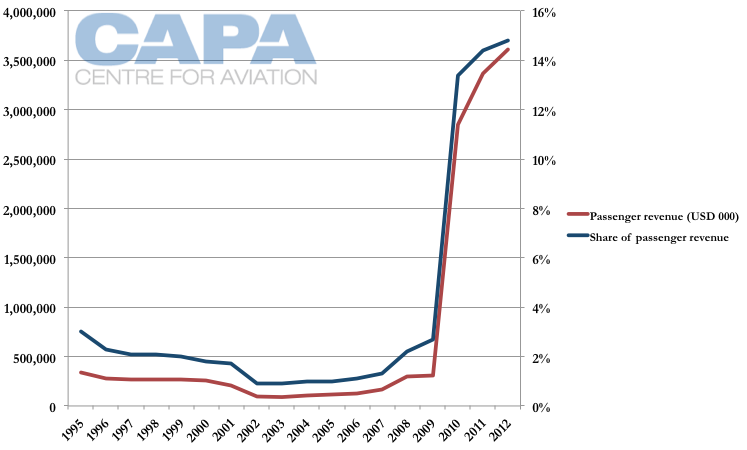 747" height="450" />
747" height="450" />
